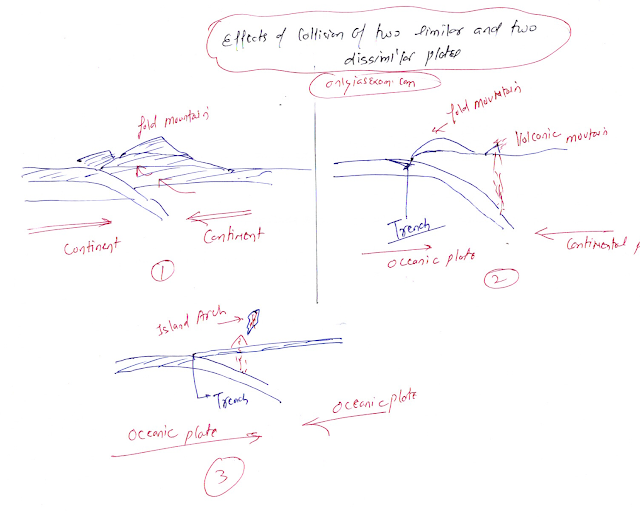Question.
Describe the concept of plate tectonics and explain the effects of the collision of two similar and two dissimilar plates. (UPPSC 2020)
Discuss the theory of Plate Tectonics with reference to the three margins and their associated features. (UPPSC 2010)
Answer.
The plate tectonics theory is a modern theory that explains the current position of the continents and oceans, as well as the formation of the major landforms of the Earth.
The theory of plate tectonics was proposed by McKenzie, Parker, and Margon in 1967.
Concept of Plate Tectonics Theory:
- According to the theory, the lithosphere is made up of the crust and upper part of the solid mantle (above the asthenosphere). The lithosphere is divided into seven (7) major and about 15 more minor plates.
- Each plate may consist of continents and oceanic crust. But we generally say that a plate is a continental plate if the majority of the area of the plate is covered by continental crust, otherwise, we call it an oceanic plate.
- The continental plate is lighter because it is made of sial (silicon and aluminum).
- The oceanic plate is heavier because it is made up of SiMa (silicon and magnesium).
- All these plates move in a particular direction by a few mm to cm per year.
- Convection cells inside the mantle are the driving force for the movement of plates.
- Major landforms such as mountains, and trenches; And events like earthquakes and volcanoes happen at the boundary zone of two plates.
There are three margins( types of boundaries) of plate movement:
- Convergent Margin
- Divergent margin
- Transverse Margin
There are the following modes of collision of two identical and two different plates:
- continental-continental convergence
- continental-ocean convergence
- ocean-ocean convergence
Effects of Continental-Continental Collision:
- The highest fold mountain is formed.
- For example, the Himalayan Mountains are formed in the collision zone between the Indian Plate and the Eurasian Plate.
- Earthquakes occur from time to time in the convergence zone.
Effect of collision of oceanic plates and continental plates:
- Fold mountains are formed on the continental margin. For example, the Andes and the Rocky Mountains form at the convergence zone of the Pacific Plate and the American Plate.
- Volcanic mountains are also formed above subduction zones and on the continent. For example, there are many volcanic mountains in the Andes and the eastern side of the Rocky Mountains.
- Earthquakes keep happening in this area.
- Troughs are also formed near the edge of the sea and the subduction zone.
Effects on the collision of two oceanic plates:
- A volcanic island arc is formed at the boundary zone. For example, the islands of Tonga and Mariana are formed on the convergence zone of two oceanic plates.
- A deep trough is formed at the boundary. For example, the world's deepest trench, such as the Mariana Trench, is in the Pacific Ocean. Mariana trench is formed in the subduction zone between the Mariana plate and the Pacific plate.
- Earthquakes also keep happening a lot.
You may like also:

ConversionConversion EmoticonEmoticon